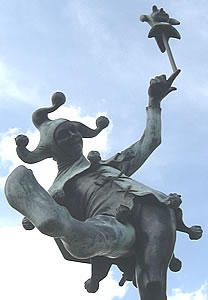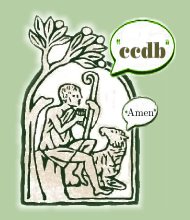Inside Higher Ed asks " Anti-Catholic or Just Art?"
I'm not seeing it. Honestly. Inside Higher Ed covers a controversy here. Sounds more like a tempest in a tea pot:
Two years ago, as part of its eighth annual outdoor sculpture exhibit, Washburn University placed in a prominent spot on its Topeka, Kan., campus a statue of what appeared to be a Roman Catholic cardinal. The artist who created Holier Than Thou, as it was titled, said it portrayed what he remembered seeing when he went into a confessional booth for the first time at the age of seven: a potent and scary figure “who had the power to condemn me for my evil ways.”A U.S. Circuit Court of Appeals Panel didn't see it, either:
What the artist intended as an ironic recollection of childhood memory struck others as egregiously anti-Catholic. They took offense at the holy man’s contorted expression and contended that the miter atop his head resembled a penis. A photograph of the statue quickly made the rounds of conservative Catholic sites on the Internet, and Catholics near and far, including the local archdiocese, asked Washburn officials to take the statue down. The university did not, and in October 2003, one professor and one then-student at Washburn sued the public institution, charging that it had violated the Establishment Clause of the U.S. Constitution by engaging in state-sponsored disapproval of their religious beliefs.
Thursday, a three-judge panel of the U.S. Court of Appeals for the Tenth Circuit ruled that the university had done no wrong. In its written opinion, the court avoided weighing in on whether the statue’s content presents a state-sponsored anti-Catholic message; what’s important, the appeals panel ruled, is that “any reasonable observer viewing it in context would understand the university had not endorsed that message.”I understand the local Archdioceses' desire to see the statue nixed. Such a controversial sculpture that could appear, to some Catholics at least, as anti-Catholic would not be something they would refuse to comment upon. However, I'm not seeing it.
To reach that conclusion, the court analyzed whether, in choosing to display the sculpture and in continuing to display it even after objections were raised, the university sought to “denigrate the Roman Catholic religion.”
The court found that neither the jury that recommended the statue nor Washburn’s Campus Beautification Committee, which ultimately selected the five pieces to be in that year’s exhibit, considered anything but the artistic quality of the work. In deciding to keep displaying the statue after the initial protests, the court concluded, Washburn’s president and its Board of Regents had cited a desire to “promote freedom of speech and to avoid academic censorship.”
It added: “There is no evidence in the record showing that the university’s decision to retain the statue was based on improper motives. Instead, the evidence shows that the university chose to keep the statue for reasons unrelated to a disapproval of Catholicism.”
This whole thing reminds me of when a group of baptists and other Christians protested the Lion King. When the Lion plopped down on the ground to sleep, a pile of dust floated into the air. The Christians in question claimed that the dust swirled into the word "sex", which they believed was inappropriate in a children's movie. Had it truly been there, they would have been right. However, no one else could discern such imagery in the questioned scene.
I find the same lack of evidence here. I mean, come on! A miter that resembled a penis? I'm just not seeing that.
There are enough examples of anti-Catholic behavior out there. Some of them go unchallenged because some of us waste our time on issues like this. The last thing Catholics need is to be perceived as the latest Chicken Little, running around crying, "the sky is falling!" every time we think we see another anti-Catholic expression somewhere. Let's keep our eye on the ball, instead, and challenge the truly anti-Catholic measures in our midst.





















<< Home